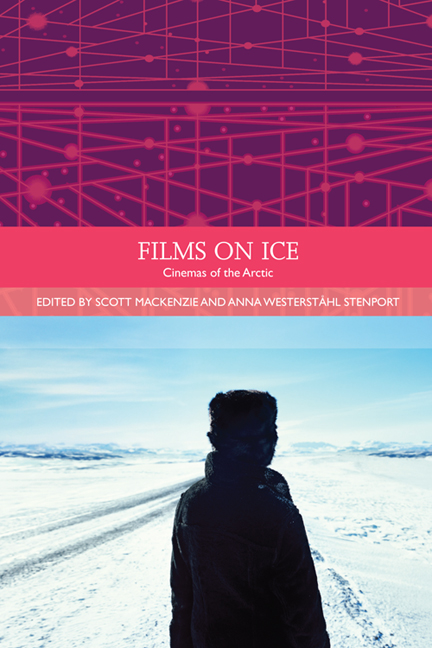Book contents
- Frontmatter
- Contents
- List of Illustrations
- Acknowledgements
- Traditions in World Cinema
- Introduction: What are Arctic Cinemas?
- PART I GLOBAL INDIGENEITY
- PART II HOLLYWOOD HEGEMONY
- PART III ETHNOGRAPHY AND THE DOCUMENTARY DILEMMA
- 14 The Creative Treatment of Alterity: Nanook as the North
- 15 From Objects to Actors: Knud Rasmussen's Ethnographic Feature Film The Wedding of Palo
- 16 Arctic Travelogues: Conquering the Soviet North
- 17 A Gentle Gaze on the Colony: Jette Bang's Documentary Filming in Greenland 1938–9
- 18 Exercise Musk-Ox: The Challenges of Filming a Military Expedition in Canada's Arctic
- 19 The Tour: A Film About Longyearbyen, Svalbard. An Interview with Eva la Cour
- PART IV MYTHS AND MODES OF EXPLORATION
- Notes on the Contributors
- Index
19 - The Tour: A Film About Longyearbyen, Svalbard. An Interview with Eva la Cour
from PART III - ETHNOGRAPHY AND THE DOCUMENTARY DILEMMA
Published online by Cambridge University Press: 05 September 2016
- Frontmatter
- Contents
- List of Illustrations
- Acknowledgements
- Traditions in World Cinema
- Introduction: What are Arctic Cinemas?
- PART I GLOBAL INDIGENEITY
- PART II HOLLYWOOD HEGEMONY
- PART III ETHNOGRAPHY AND THE DOCUMENTARY DILEMMA
- 14 The Creative Treatment of Alterity: Nanook as the North
- 15 From Objects to Actors: Knud Rasmussen's Ethnographic Feature Film The Wedding of Palo
- 16 Arctic Travelogues: Conquering the Soviet North
- 17 A Gentle Gaze on the Colony: Jette Bang's Documentary Filming in Greenland 1938–9
- 18 Exercise Musk-Ox: The Challenges of Filming a Military Expedition in Canada's Arctic
- 19 The Tour: A Film About Longyearbyen, Svalbard. An Interview with Eva la Cour
- PART IV MYTHS AND MODES OF EXPLORATION
- Notes on the Contributors
- Index
Summary
Q. What is The Tour?
The Tour is a video montage produced as part of a thesis on Media and Visual Anthropology at the Freie Universitat in Berlin, based on fieldwork in Longyearbyen on Svalbard in 2011 – a Norwegian archipelago in the High Arctic. Here I focused on a set of research questions around the relationship between lived and projected realities on Svalbard, which I sought to explore among a group of taxi drivers and by working as a taxi driver myself.
Retrospectively I would say that I was exploring, on the one hand, the notion of the guided tour as an institution for authorised perspectives on ‘the ideal’ and, on the other hand, the figure of the guide as an individual with personal motives, anticipations and value judgments relative to the place. The guided tour of Longyearbyen was interesting to me as Svalbard in many ways functions as representative for the Arctic, particularly visually. However, in crucial respects Svalbard challenges traditional ideas and perceptions of anthropology within regional Arctic studies, as the archipelago does not have a native population. Rather, the social environment on Svalbard has always been characterised by a great sense of temporality, as settlers of many different nationalities have come to work at the islands for a limited period of time: as whalers, explorers, scientists and miners, but also as service workers in the growing tourism industry, or merely as visitors and adventurers. This means that a high turnover of people has taken place continuously. Being there as an anthropologist, oneself becomes part of a shifting community within and across Svalbard, contributing to undermine the idea of a coherent and permanent community within certain geographical parameters. Today, residents stay at Svalbard for an average period of only four years.
Only a few people have lived in Longyearbyen, the main settlement of the islands, for most of their life. It is more common to leave the islands after a limited period of time and then, eventually, come back up again for another period of time. While Longyearbyen has around 2,000 inhabitants, many more people may have a feeling of belonging to the place.
- Type
- Chapter
- Information
- Films on IceCinemas of the Arctic, pp. 255 - 260Publisher: Edinburgh University PressPrint publication year: 2014



